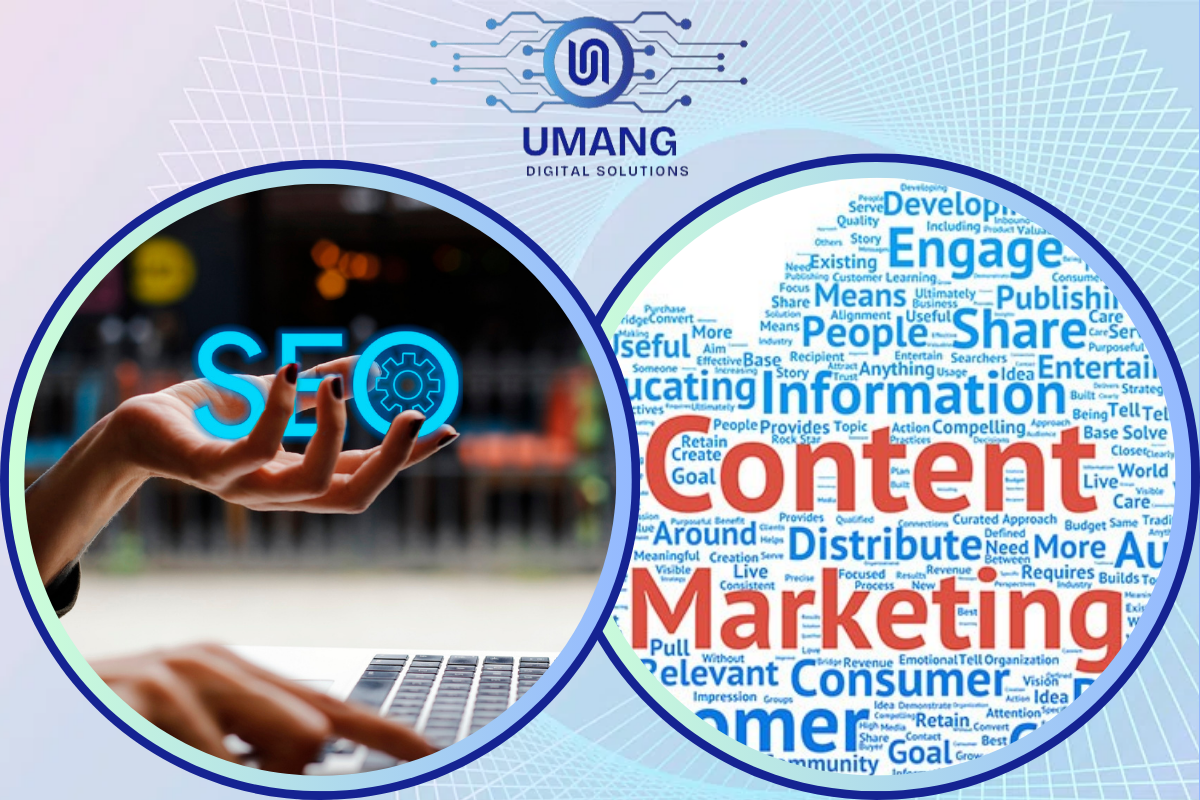SEO and Content Marketing
How to Make Your Content Search Engine Optimized
For companies of all sizes, having a strong online presence is crucial in the current digital environment. Content marketing and SEO (Search Engine Optimization) are two essential elements in accomplishing this. Even while each of these tactics has the potential to be quite effective on its own, combining them will greatly increase your exposure and interaction. In order to increase traffic and conversions, this blog will discuss how to optimize your content for search engines by utilizing SEO and content marketing strategies.
UmaNg
- What is SEO?
- What is Content Marketing?
- Keyword Research: The Foundation of SEO and Content Marketing
- Creating High-Quality, SEO-Friendly Content
- On-Page SEO Techniques
- Off-Page SEO Techniques
- Monitoring and Adjusting Your Strategy
What is SEO?
Optimizing your website and content to rank higher in search engine results pages is known as SEO, or search engine optimization (SERPs). The objective is to improve your website's relevance and usability for both search engines and visitors in order to boost organic (non-paid) traffic.
What is Content Marketing?
Content marketing aims to attract and retain a specific audience by the creation and distribution of current, relevant, and well-written content. Driving lucrative consumer action, such as lead generation, sales, or brand exposure, is the ultimate objective.
The Symbiosis of SEO and Content Marketing
Content marketing and SEO are closely related. Effective SEO requires high-quality content since search engines give preference to websites that offer users useful information. On the other hand, SEO strategies make sure that more people see your content. Here's how to combine content marketing techniques with SEO to make your material more search engine friendly.
Keyword Research: The Foundation of SEO and Content Marketing
Why Keyword Research Matters
The backbone of both SEO and content marketing is keyword research. It entails figuring out what words and phrases your target audience uses to search for information so that you can provide content that answers their queries and meets their demands.
How to Conduct Keyword Research
1.Use Keyword Research Tools:
You may locate suitable keywords with a high search volume and little competition by using tools like Ahrefs, Moz, SEMrush, and Google Keyword Planner.
2. Analyze Competitors:
Examine the keywords that your rivals are ranking for. This might give you information about what functions well in your sector.
3. Focus on Long-Tail Keywords:
These are more detailed, longer terms with greater conversion rates that may have fewer search volume hits. They frequently point to a person who is getting nearer to completing a transaction or choice.
Creating High-Quality, SEO-Friendly Content
Understand User Intent
The motivation behind a search query is referred to as user intent. Four primary categories of user intent exist:
1. Informational:
The user is trying to find out something.
2. Navigational:
The user is trying to find a particular website.
3. Transactional:
The user plans to buy something.
4. Commercial Investigation:
The user is looking at goods and services.
Knowing what your audience wants from your material is essential for content marketing and search engine optimization (SEO).
Optimize Content Structure
Users and search engines alike favor information that is well-structured. Here's how to improve the organization of your content:
1. Use Headings and Subheadings:
Use H1, H2, H3, and so on to divide your information into sections. This improves readability and aids search engines in deciphering the structure of your material.
2. Write Compelling Meta Descriptions:
Meta descriptions have an impact on click-through rates even if they have no direct effect on rankings. Compose succinct, compelling meta descriptions that incorporate your main keywords.
3. Use Short Paragraphs:
To make paragraphs easier to read, keep them brief (2 to 3 phrases).
4. Include Bullet Points and Numbered Lists:
These components highlight key topics and break up the text.
Incorporate Keywords Naturally
Although it's crucial to incorporate keywords into your writing, stay away from keyword stuffing as it may lower your ranks. Here's how to make efficient use of keywords:
1. Primary Keywords:
Make sure your main term appears in the headline, opening paragraph, and conclusion. Also, include it organically into the text.
2. Secondary Keywords:
Use related terms and secondary keywords in subheadings and the body of your writing.
3. LSI Keywords:
Terms associated with your primary keyword are known as Latent Semantic Indexing (LSI) keywords. Make use of them to add significance and context.
Create Engaging and Valuable Content
Your audience will value your content more if it ranks highly. Here's how to make sure the stuff you write is interesting:
1. Provide Comprehensive Information:
To establish yourself as an authority on your subject, write a thorough analysis of it.
2. Use Visuals:
Incorporate pictures, videos, infographics, and other visual components to increase the shareability and engagement of your content.
3. Encourage Interaction:
To promote engagement, pose queries, welcome feedback, and use calls-to-action (CTAs).
On-Page SEO Techniques
Optimize Your URLs
Ensure that your URLs contain your main keyword and are clear and succinct. Steer clear of long, complicated URLs that contain extraneous parameters.
Use Internal and External Links
1. Internal Links:
Provide links to other pertinent pages on your website to enhance user experience and maintain user engagement.
2. External Links:
Include links to reliable, pertinent websites in your work to give it more authority and context.
Optimize Images
1. Use Descriptive File Names:
Before uploading, rename image files to incorporate pertinent keywords.
2. Add Alt Text:
Put keywords and a description of the image in the alt text. This increases accessibility and aids search engines in deciphering the image content.
Improve Page Load Speed
Pages that load quickly are essential for both user experience and SEO. To find and address problems causing your website to load slowly, use tools such as Google PageSpeed Insights.
Off-Page SEO Techniques
Build High-Quality Backlinks
Reliability and content value are sent to search engines by backlinks from reputable websites. The following are some methods for creating backlinks:
1. Guest Blogging:
Write guest posts for reputable websites related to your field.
2. Broken Link Building:
Look for broken links on other websites, then submit your material to take their place.
3. Create Shareable Content:
Create original, high-quality content, such research reports, infographics, and in-depth tutorials, that others will want to link to.
Engage on Social Media
Use social media networks to promote your content and generate visitors to your website. Likes, shares, and comments are examples of social signals that can help your SEO indirectly by increasing the visibility and reach of your content.


Monitoring and Adjusting Your Strategy
Use Analytics Tools
Using resources like Google Analytics, Google Search Console, and other SEO software, keep a regular eye on the functionality of your website. Pay attention to metrics such as organic traffic, bounce rate, average session length, and conversion rates.
Conduct Regular SEO Audits
Conduct routine SEO audits to find and address problems that can be influencing your rankings. This includes searching for bogus information, faulty links, and websites that load slowly.
Update and Repurpose Content
Content marketing and SEO are continuous efforts. Maintain the accuracy and relevance of your material by updating it frequently. To reach a wider audience, repurpose content that performs well into multiple formats. An example of this would be to adapt a blog post into a video or infographic.
One of the most important elements of an effective digital marketing plan is search engine optimization of your content. You may produce worthwhile, interesting content that not only draws in and keeps your target audience but also performs well in search engine results by combining SEO with content marketing. Begin with in-depth keyword research, produce content of the highest caliber, use both on-page and off-page SEO tactics, and keep an eye on things and tweak your plan as needed. You'll be well on your way to becoming an SEO and content marketing guru, increasing traffic, and accomplishing your business objectives if you follow these steps.

